Jejuri: A Reflection in Nine Frames
Who was that, you ask.
The eight arm goddess, the priest replies.
A sceptic match coughs.
You can count.
But she has eighteen, you protest.
All the same she is still an eight arm goddess to the priest.
You come out in the sun and light a charminar.
Children play on the back of the twenty foot tortoise.
—"A Low Temple", Jejuri, Arun Kolatkar (1974)
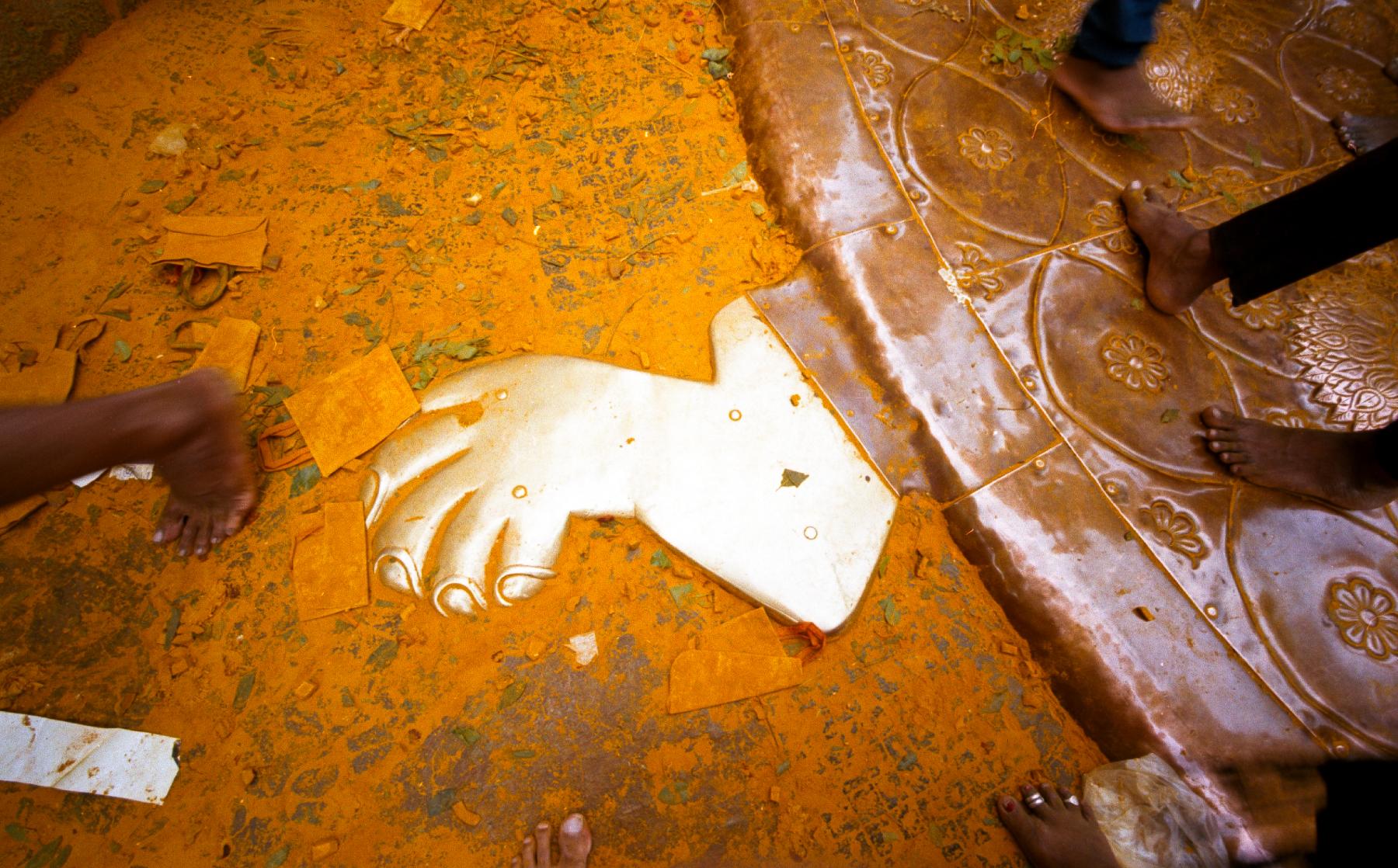
1. The Twenty-Foot Tortoise with copper and brass detailing stands just outside the entrance to the temple structure. This large tortoise becomes overflow space for the temple and a space for play and respite.
First built in the twelfth century AD with a few subsequent reconstructions, the Khandoba temple at Jejuri is one of the most prominent and popular pilgrimage sites in Maharashtra, with millions of devotees who visit annually. The opening lines in this essay are from Arun Kolatkar’s 1974 poetry collection, Jejuri, a series of vignettes from the poet’s visit to the temple. Written in a spare, even severe style, the collection won the Commonwealth Poetry Prize in 1977. In these poems, the poet presents himself as an outsider to the site, observing with a detached distance. I was interested in exploring the tension between the flaneur, the outsider looking in and the site, whose history and significance demands attention in its own right.
Khandoba, the deity at Jejuri, is the family deity for many Marathi-speaking families, including mine. I am told that I first went to Jejuri as a child, then as a teenager and a third time in 2007. Inexplicably, I have no recollection of any of these visits, but despite the lack of religious motivation, I decided to visit again in the summer of 2024; this time I wanted to see it as a historian and architect.
My research into the history of working-class movements in western India and its intersections with the process of caste-identity formation gave new relevance to the significance of sites like Jejuri, which have played an important role in the making of Dalit memory, politics and identity-formation in the region. At the same time, the challenge was to create a critical distance from a site that is part of my own Brahmin family’s history and a deity whose image I have seen at home since I was a child.
Rajeev Patke’s essay “Poetry since Independence” describes Kolatkar’s Jejuri as a “glass-poem”: “…what you think you see through is the place, what you really see is your own reflection trying to look through.” What better way to explore this tension between seeing and creating an image of oneself than with a camera, which will produce images that represent something observed, while images themselves become objects of scrutiny?
Image-making has become a ubiquitous activity since the advent of phone cameras, but perhaps this is also what makes the process of carrying an analogue camera, especially to a site that had crowds and rain, an opportunity for reflection. The camera helped create a distance from the act of “seeing,” especially since the images were mediated through time. I made the images on Kodak Vision3 250D film which could only be processed back in Mumbai. This meant that it was several days before the images could be seen. The process prevented me from “chimping”—looking at the camera screen immediately after each photo was taken in order to assess it—helping me remain firmly in the moment.
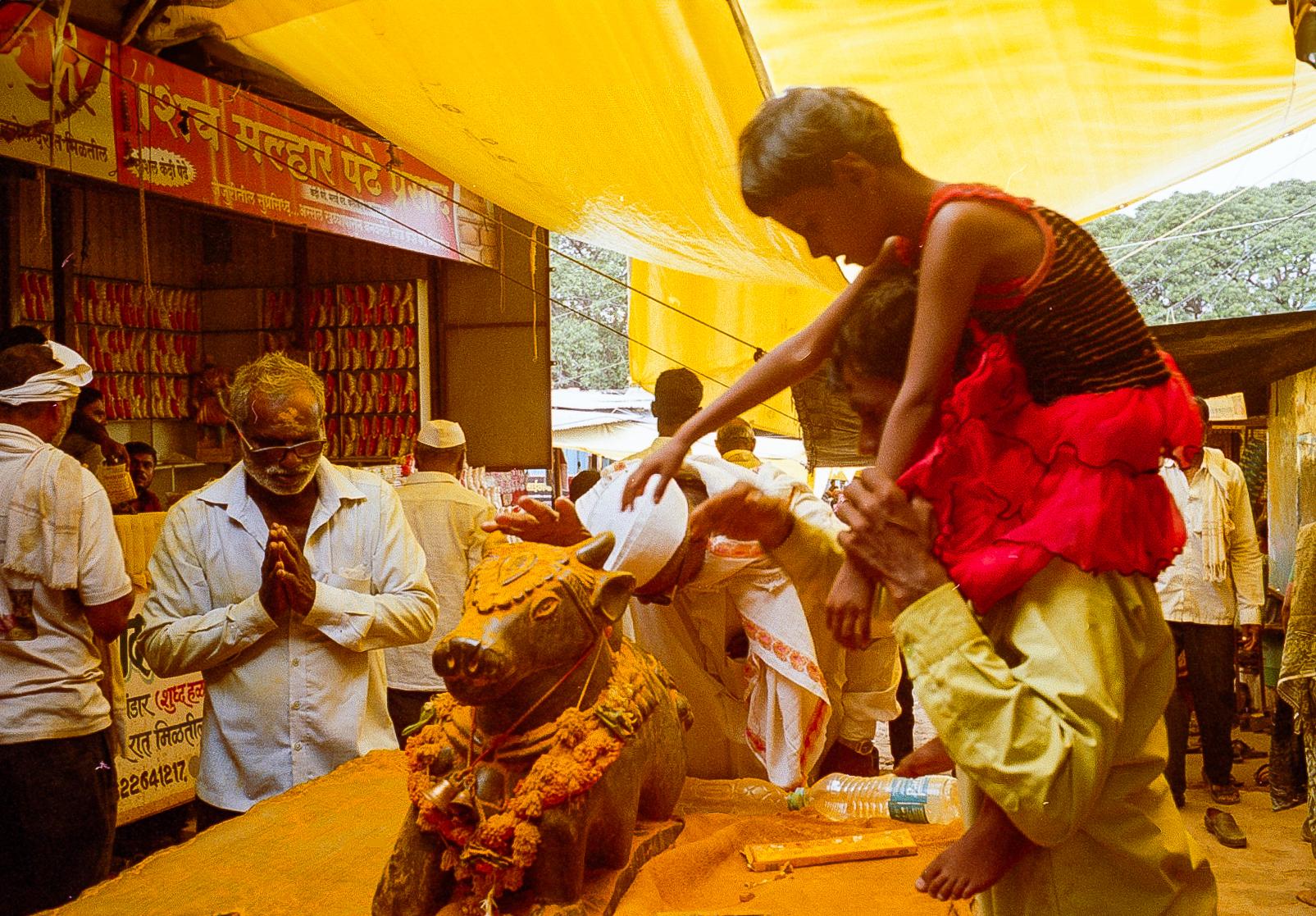
2. Saturated Frames.
Turmeric is a crucial part of the ritual prayer to Khandoba at Jejuri. It turns everything yellow, and the effect is foreshadowed by the yellow tarpaulin that stretches across the roughly 300 steps that one must climb to reach the Jejuri Qila (fort) that houses the temple. Khandoba is now considered to be an incarnation of Shiva, but his origins are as a tribal god, a deity of the Dalit-Bahujan-Adivasi communities, and the temple complex is not a space where they need to assert their claim explicitly—it is a space that belongs to these communities.
Jejuri and Khandoba are integral parts of many Dalit memoirs and experiences, but the site and the deity are also closely linked with the history of Dalit politics itself. For example, in the first decades of the twentieth century, the periodicals Somavanshiya Mitra and Bahishkrut Bharat were at the forefront of organising marriages for muralis—young Dalit girls that were “wed” to Khandoba but, in fact, were often forced into prostitution by the priests—and campaigns to end the practice of muralis was an important instance of social reform.
Kodak's Vision3 250D film, designed for use in cinema, is renowned for its bright saturated colours. I was glad that I used this film for the yellow turmeric, although it is difficult to process and a local lab left some frames with many scratches that have not been removed digitally.
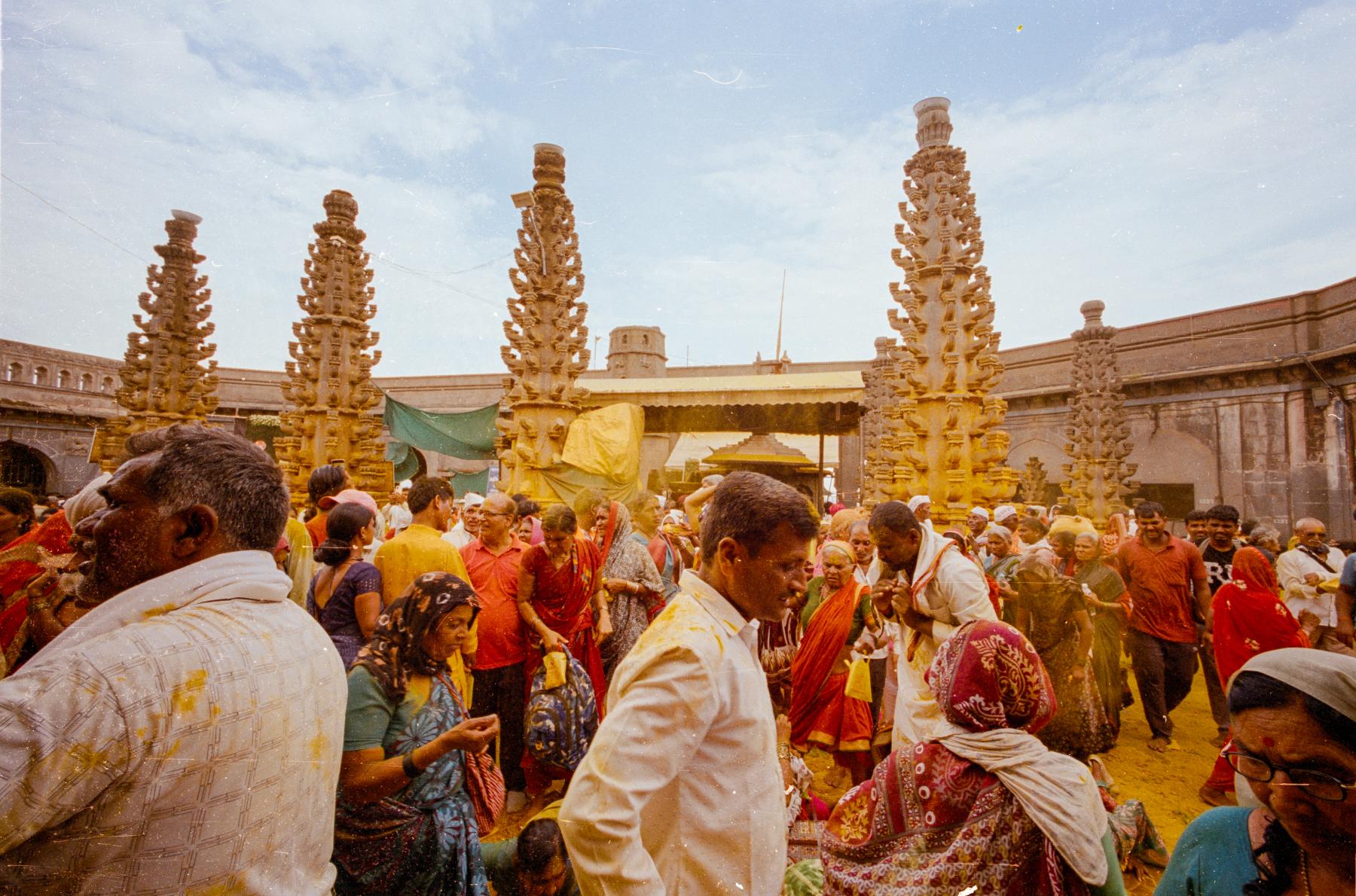
3. A Yellow Storm.
After climbing the 300 steps, a narrow conduit leads into the relief of a large courtyard, surrounded by the black basalt rock typical of the local Hemadpanthi architecture. This thirteenth-century style is renowned for its elaborate stone carvings, paired with relatively simple architectural plans. Given that it was also a popular style for Maratha forts, the temple, built on a hill, is itself reminiscent of a small fort with a wall surrounding it.
It was a special day in Jejuri as over one million devotees had descended on the temple town en route to the temple town of Pandharpur, part of a massive 21-day walking pilgrimage undertaken by countless people in the region. The air was yellow with turmeric. The presence of such a large gathering of people from all over the region, tied together by faith, would challenge any flaneur. It threw the presumed neutrality of an observer into sharp relief, but the task and the physical motions associated with photography allowed for a certain respite.
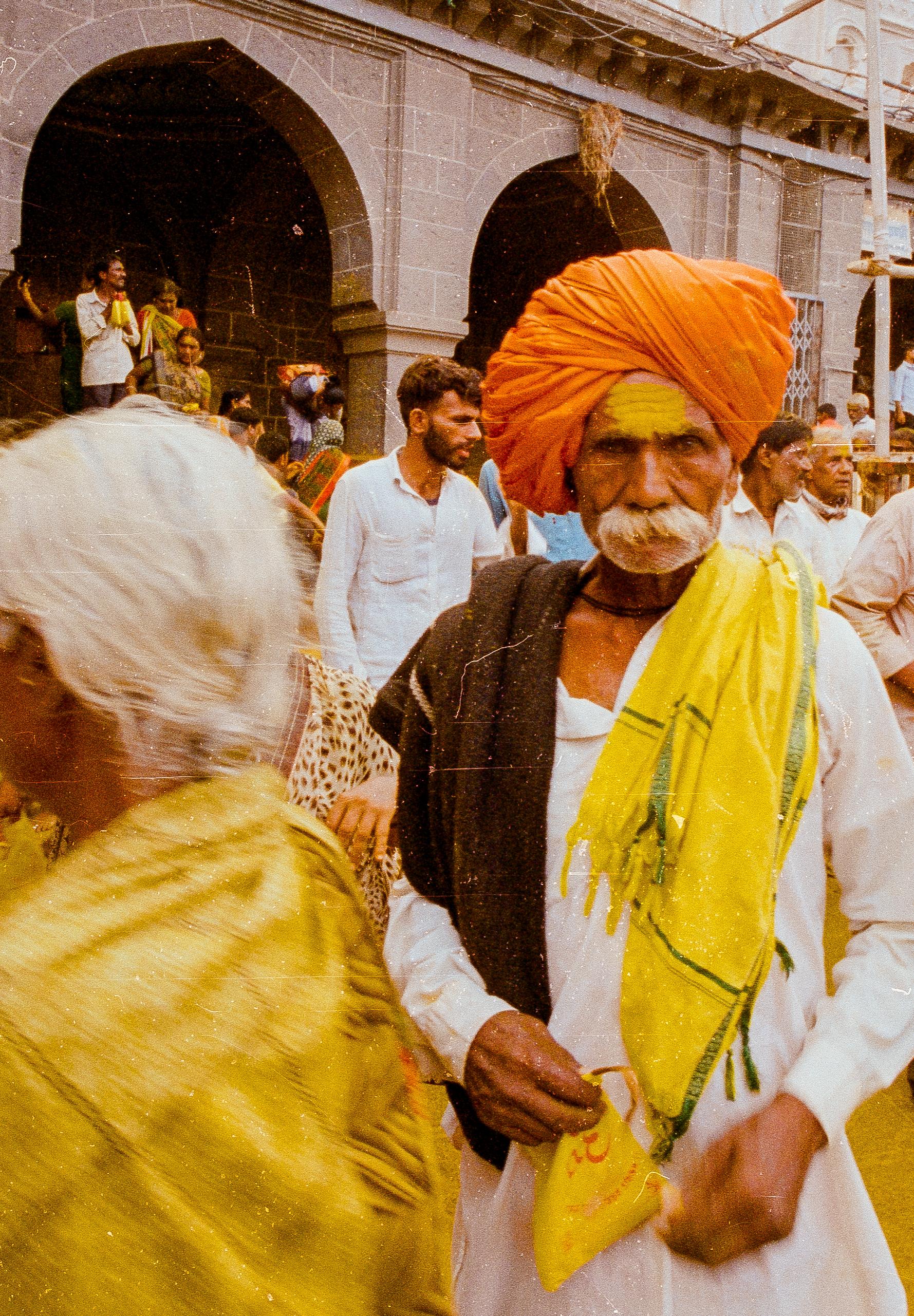
4. A Snapshot. A record of a beautifully tied orange turban. The gentleman handed some turmeric in return.
Khandoba is but one of many deities that began their career as a peasant or “folk” deity and was later incorporated into the Hindu pantheon. In addition to religious texts, he also finds mention in the anti-caste reformer Jotirao Phule’s seminal 1873 work Gulamgiri, where he identifies Khandoba as a regional chieftain of the mythical King Bali. The cult of Khandoba is “principally a non-Brahmin cult” dominated by peasant castes along with a sizeable Dalit following, although many Brahmin families also consider him their family deity. In his essay “The Capitulation of Mani: A Conversion Myth in the Cult of Khandoba”, John M. Stanley draws on the Mallari Mahatmya, the officially sanctioned story of Khandoba, to explain the eventual Sanskritisation of this deity, and it can be hypothesised that the induction of Khandoba as a deity for Deshastha Brahmins may have happened after said Sanskritisation.
Importantly, despite this Sanskritisation, the priests at Jejuri are not strictly Brahmins. Instead, they are from the Gurav community, which is an occupational classification drawn mainly from the peasant castes but serving in various priestly roles. It is perhaps for this reason that some religious practices, described in Marathi as ugra (aggressive or radical), include offering a ritual sacrifice of goats and the preparation of a salt-and turmeric-cured goat meat dish called kanduri. The dish finds mention in several Dalit memoirs, including Aamcha Baap Aan Amhi (1993) by noted economist and educator Narendra Jadhav, who describes his mouth watering at the mere thought of kanduri.
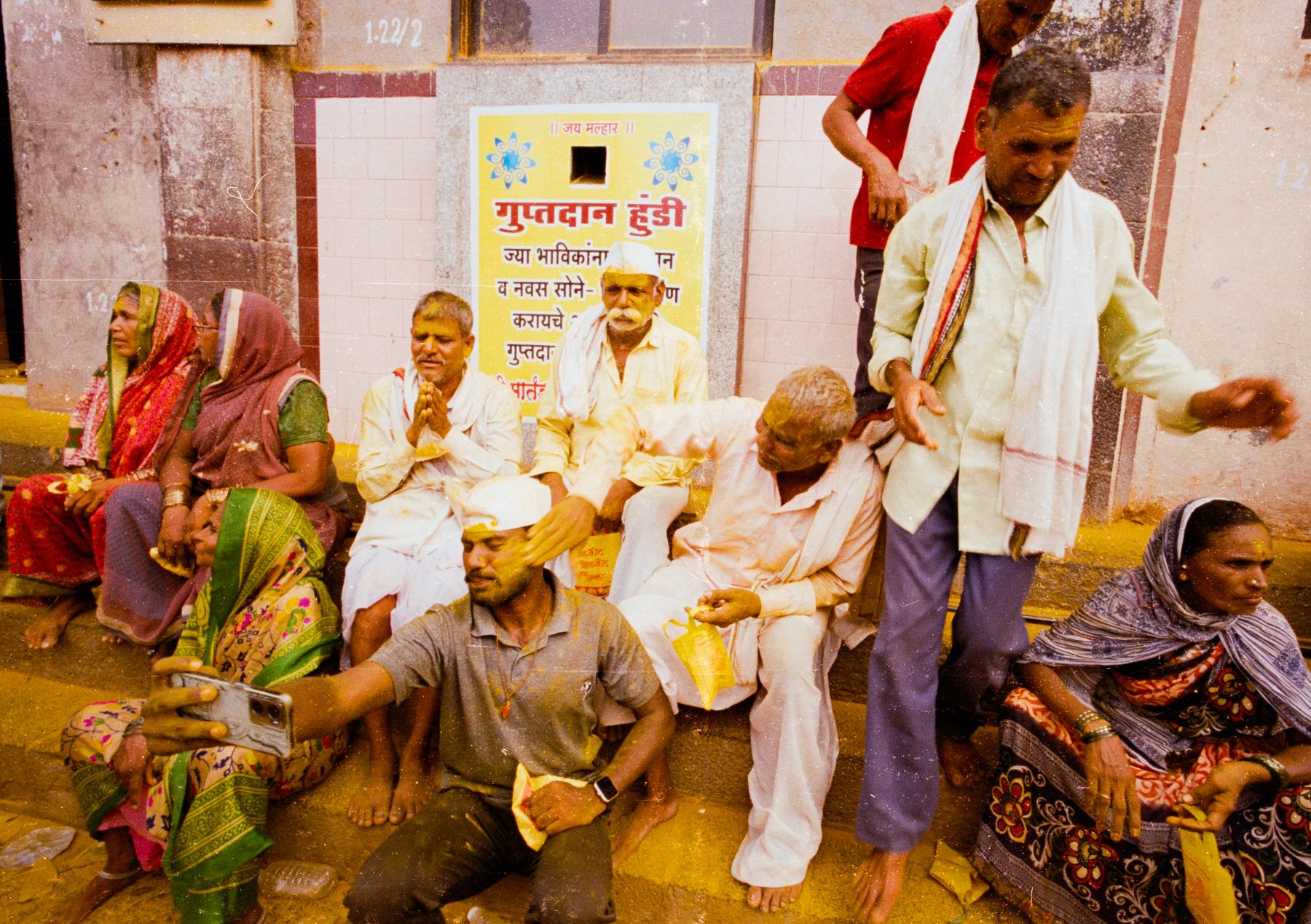
5. Foreground Activities.
The devotees had a contagious energy. People praying, taking selfies, smearing turmeric on one another’s face, or simply people-watching. This image captures a moment of rest—the action happens along the temple structure and in the procession around it, while the peripheries are spaces for respite, for quiet prayer, or simply act as a meeting spot.
The temple and the deity seem to fulfil a devotional as well as a social function. Khandoba is prominently mentioned in Baluta, the pioneering Dalit memoir by Daya Pawar, first published in 1978. A neighbour’s threat that his sister would be given away as a murali; the ritual bathing of the image of Khandoba at home; the fondly remembered story of Khandoba’s lover Mhalsa, whose shrine, by dint of her caste, would always be placed at a lower height in temples; such images paint a rich picture of the role played by the deity in Pawar’s life as an adolescent. For Dalit devotees, Jejuri means more than the temple that is the home of Khandoba; visiting Jejuri is an important event in itself.
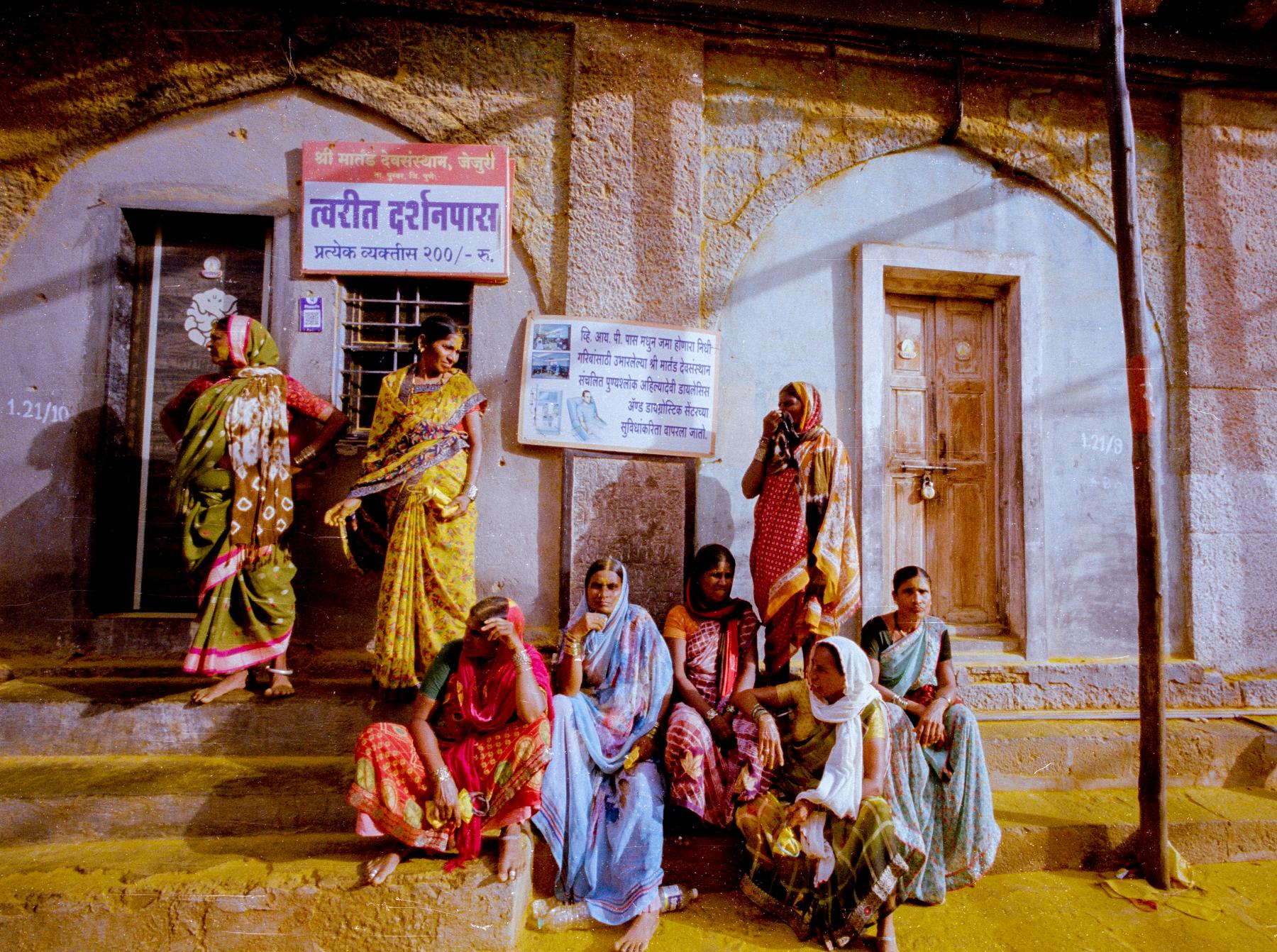
6. Perfect Backdrops.
The rain had relented just a bit that day, and the pointed arches of the temple made for gorgeous backdrops for the crowds. These women had travelled together and were en route to Pandharpur. The overpoweringly yellow palette, where the entire temple grounds were covered with turmeric, offered a quiet continuity to these images. Without it, one may find it difficult to imagine that the third image and the sixth were taken just a few feet from each other. The ability of the temple complex to produce such intimate spaces while also containing many thousands of visitors at a time is remarkable.
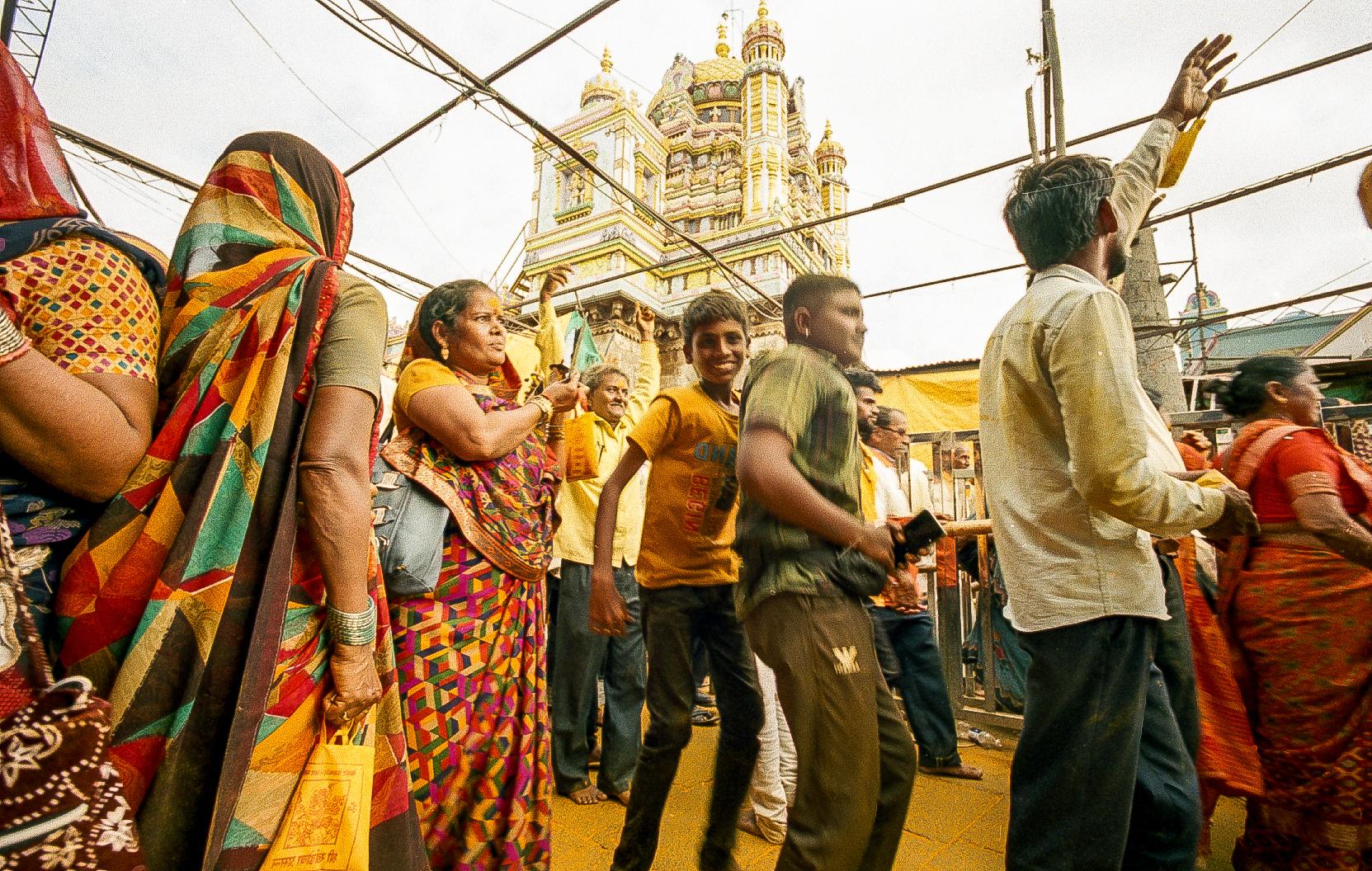
7. Dance.
The atmosphere was celebratory not just inside the temple complex but in the city below as well. The air was carnivalesque, as social hierarchies were turned upside down. The performance of devotion allowed for otherwise suppressed energies to be expressed openly in the form of dances and trances. But devotees saw the actual statue of Khandoba for just a few seconds; the lines were long, and you could bypass the crowds by paying some money. A temple is a sanctified space and a business after all—not all hierarchies can be inverted.
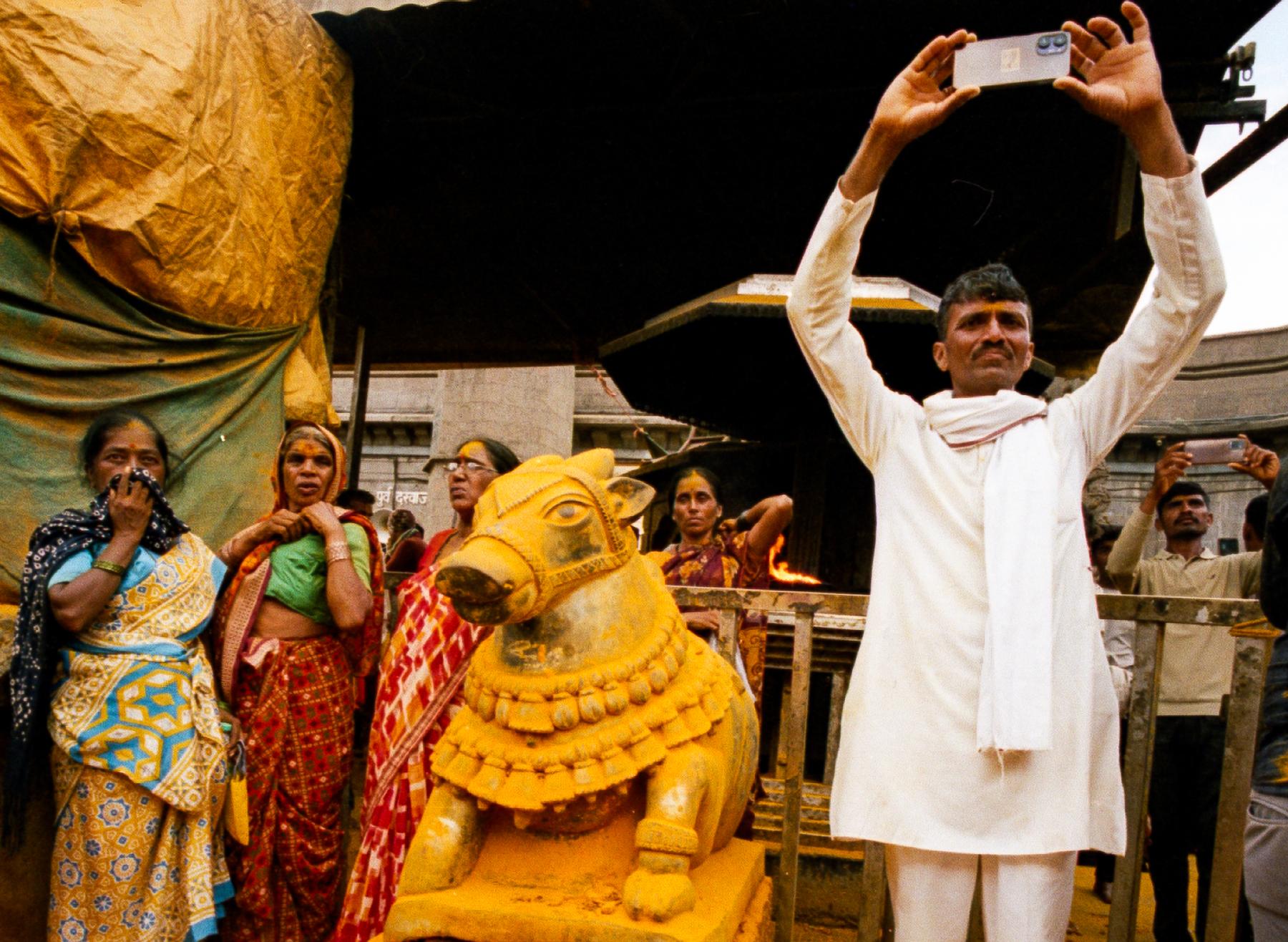
8. Self-Reflections.
For many visitors, the process of visiting Jejuri and the process of image-making was concurrent and perhaps even identical. Memoirs are a crucial source in Dalit studies, and the act of visiting sites like Jejuri—a long and expensive trip for many—can oftentimes become a metaphorical form of keeping time and marking life events. Visiting Jejuri therefore is an important event, and such events must be appropriately recorded. Daya Pawar’s grandmother used Jejuri to describe the extent of the small world they occupied, while Narendra Jadhav’s trip to Jejuri signalled the beginning of his married life in his memoir. Inside the temple complex, this visit as an event translated into excited video calls, selfies and even live broadcasts on social media by visitors.
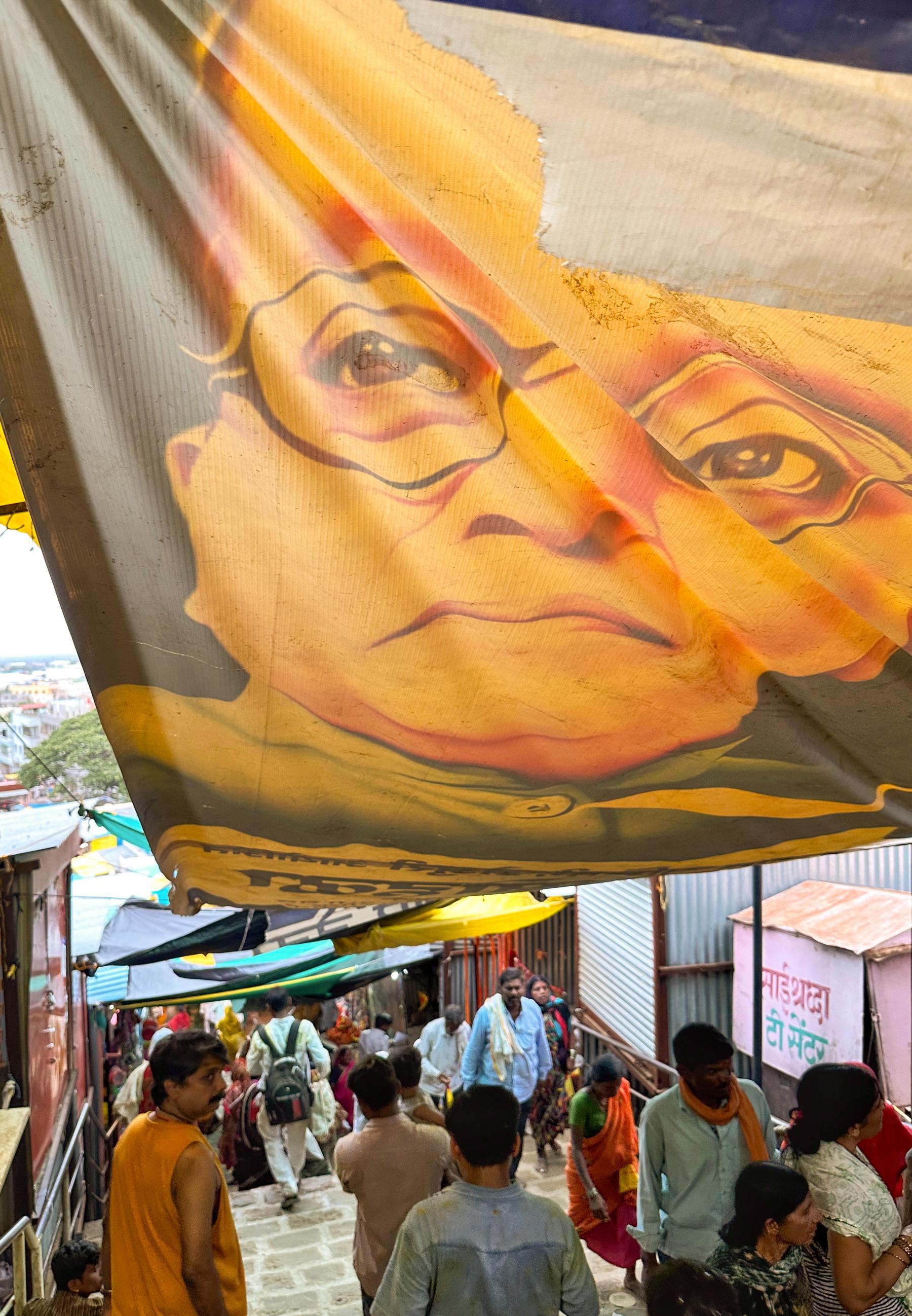
9. An Alternate Iconography and Cosmology.
As I exit the temple, on the way down, I notice that a large political banner featuring Dr B.R. Ambedkar has been repurposed to cover the stairs, providing shade and shelter. It serves as a discreet reminder of the history of the place and its role in the formation of Dalit and Bahujan identities, but it is also a very good spot to wait out the rain.
To learn more about analogue image-making, read Radhika Sharma’s conversation with photographer Vijay Sarathy on the lack of boundaries between the camera and the mind’s eye, the process of chronicling one’s home town in Satish Kumar’s coming-of-age narrative, and on performative storytelling through interactions between the epic, the personal and the analogue in Najrin Islam’s interview with Ashish Sahoo.
All images by Ninad Pandit. Images courtesy of the author.




